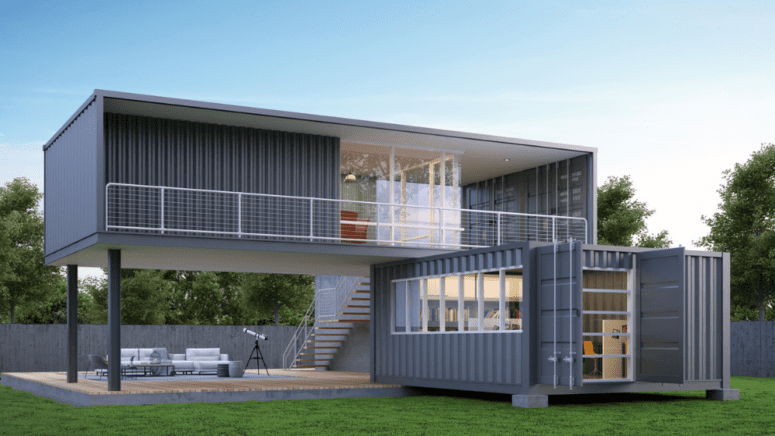Thinking Outside the Box: Your Guide to Shipping Container Home Design
- Published on
- 6 min read
-
 Kaitlynn Copinger, Contributing AuthorClose
Kaitlynn Copinger, Contributing AuthorClose Kaitlynn Copinger Contributing Author
Kaitlynn Copinger Contributing AuthorKaitlynn Copinger is a freelance writer based in Virginia Beach. She is a former newspaper reporter with more than a decade of professional writing experience. Having bought and sold one house, then relocating and purchasing another, Kaitlynn knows well the challenges and joys of home ownership.
-
 Joseph Gordon, EditorClose
Joseph Gordon, EditorClose Joseph Gordon Editor
Joseph Gordon EditorJoseph Gordon is an Editor with HomeLight. He has several years of experience reporting on the commercial real estate and insurance industries.
If you’re the kind of person who thinks outside the box, then a shipping container home might be a good fit for you.
Shipping containers — those colorful blocks stacked high on cargo ships, making their way from port to port — are having a moment. With existing home inventory low, sales prices reaching record highs and the cost to build new also climbing ever higher, it’s easy to see the allure of an alternative approach like shipping container home design.
Plus, repurposing a shipping container can be more environmentally friendly. And, it doesn’t hurt that there are some really cool, modern-looking shipping container home designs out there.
Before you jump on board with this trendy choice, let’s dive into the details of container homes. We’ll explore their benefits, costs, and potential drawbacks, giving you all the information you need to decide if this architectural style is right for you.
From the high seas to residential streets
Shipping containers, now used for homes, Airbnbs, restaurants, and even clinics, were originally designed to streamline goods transport. Malcolm P. McLean, who patented the standardized metal container in 1956, revolutionized the shipping industry. Today, there are about 65 million containers globally, many unused. Though the first reported instance of shipping containers being converted into housing was in 1987, the trend gained momentum in 2007 with Peter DeMaria’s “Redondo Beach House,” the first two-story container home built to US building standards, which won an American Institute of Architects award and sparked a new architectural trend.
The benefits of container living
Durability and strength
Shipping containers, crafted from 14-gauge Corten steel, are built to endure extreme conditions. Designed to carry more than 50,000 pounds and withstand stacking, harsh weather, and global travel, they offer exceptional durability. As a building material, they surpass many traditional structures in strength, providing excellent resistance to earthquakes, storms, mold, fire, and termites, ensuring strong structural integrity and security for container homes.
Fast, easy construction
Building a shipping container home is significantly faster than constructing a traditional home due to the pre-made, modular frames. These containers are easy to transport and install, with many available as prefabricated modules. At Missouri-based Custom Container Living, homes are built indoors, avoiding weather delays. Depending on the design, your new container home could be ready in just a few weeks.
Mobility
Shipping containers are portable and can be moved with ease, either by forklift for smaller units or crane for larger setups. While utilities need to be disconnected and reconnected, the steel frame ensures the structure remains stable during transport.
Lower cost to build
Building a container home generally is more affordable than a traditional house, with costs ranging from $25,000 to $175,000, depending on size and customization. However, the price can vary significantly based on design. While earlier container homes were often smaller, minimalist structures, the trend is now shifting toward more elaborate and architecturally interesting designs, which can reach $1 million or more, according to Aaron Burch, owner of Discover Containers.
Unique designs
Container homes offer striking and innovative designs, often featuring cantilevered components and stacked configurations that push architectural boundaries. With the ability to use 10 to 20 containers, these homes can create bold and modern structures, exemplified by the impressive Jaora Street home in Brisbane. The industrial aesthetic and creative design solutions, including space-saving furniture, make the most of the compact interior, resulting in unique and stylish living spaces.
Sustainability
Upcycling a container can be an environmentally friendly way to build a house, though the sustainability of container building is sometimes debated, especially if the container has been used only once. For containers with a more storied past, their history of long journeys can add charm. Homes designed with containers bearing longshoremen’s marks or labels in various languages highlight their unique backstories.
Energy efficiency
Shipping container homes are highly energy-efficient due to their steel structure, which minimizes the need for extra materials. Their compact, modular design simplifies insulation, which can be done with eco-friendly options like recycled denim or soy-based foam. This effective insulation reduces heating and cooling energy consumption, making these homes more efficient than traditional constructions. Their small size also means less space to heat or cool, which benefits those aiming to cut their carbon footprint and lower energy bills.
The drawbacks of container living
Limited supply
The COVID-19 pandemic disrupted manufacturing and shipping globally, causing widespread factory shutdowns and slowed shipping lines. This affected the production and distribution of shipping containers, leading to a shortage and increased prices in 2024. Due to these supply issues and the focus of container companies on rentals rather than sales, acquiring new or “one-trip” containers for building homes can be both more expensive and time-consuming.
Limited space
Shipping containers are compact, with an average 8-foot x 20-foot container offering 160 square feet and an 8-foot x 40-foot container providing 320 square feet. While combining multiple containers can create more space, it will increase costs and construction time due to the need for retrofitting. It’s crucial to consider the practicality of living in such a small area and plan accordingly.
High temperatures
Without proper insulation, shipping containers can become extremely hot in summer due to their steel construction. To address this, you’ll need to add insulation, wall finishes, vents, and ideally an air conditioner, though this will reduce the already limited interior space. Insulation in a narrow container often requires adding internal stud walls and using spray-foam or rigid foam. Additionally, if modifying or combining containers, reinforcement such as welding may be necessary to ensure structural integrity.
Possible health hazards
Older or second-hand containers may pose health risks due to residual chemicals from treatments or coatings. New containers are generally safer as you can specify non-toxic treatments. However, using new containers may increase costs and reduce the environmental benefits of recycling. To minimize risks, consider using spray foam insulation, breathable underlay, and proper ventilation.
Zoning and permitting
The first crucial step in preparing for your container home installation is navigating the permitting process. Since container homes are not yet a mainstream concept, many cities lack specific regulations, which can lead to delays or denials. Local building codes and zoning regulations can vary widely, so it’s essential to consult with local authorities or an experienced contractor early on. Securing the necessary permits before starting construction ensures compliance with legal requirements and helps avoid costly delays and changes later.
Construction challenges
Shipping containers are not originally designed for residential use, so adapting them can present challenges. Cutting openings for doors and windows, installing plumbing, and addressing the small living space require creativity. Additionally, containers can rust if not properly protected. To prevent rust, apply a protective coating, manage water drainage effectively, and address any rust issues promptly to avoid structural damage and leaks.
Financing and insurance
Another obstacle can be obtaining financing and insurance, Burch says. Financing options may include mortgage, personal, or construction loans, but not all lenders and insurers provide programs or policies for shipping container homes, so you might have to do some research. A solution may be to work with a smaller bank that has more flexibility and an insurance broker used to dealing with unusual architecture.

How much do shipping containers cost?
A shipping container home may not necessarily be cheaper than traditional construction, as it involves custom architecture. Let’s start with the basics: the cost of the shipping containers themselves.
Shipping containers typically come in two standard sizes: 20 feet by 8 feet with 8.5 feet of height, providing 150 square feet of interior space, and 40 feet by 8 feet with the same height, offering 300 square feet of space. Prices for 20-foot containers range from $1,800 to $6,500, depending on whether they are new or used, while 40-foot containers cost between $3,200 and $8,300.
When budgeting, consider the cost of the land, professional labor — typically $75 to $150 an hour — and the modifications needed to make your container livable.
As with any home, your specific requirements can significantly affect the overall cost. You can order a prefab container home on Amazon.com for as little as $12,000. Custom Container Living says their container homes range from $45,900 to $219,900. Angi puts the average range at between $25,000 and $250,000. And then there’s this $2M container home in Vancouver, Washington. So clearly, container home prices can vary widely based on customization, location, and amenities.
Find your own home sweet container home
If your Instagram feed is dominated by container home images, maybe it’s time to take the next step: finding your own home sweet container home.
You have a lot of options. You can buy new from a manufacturer, though this might be less appealing since it misses the opportunity for reuse.
The eco-friendly route is to buy a used shipping container. This can also be a more affordable option, but you’ll need to pay attention to what you’re purchasing, especially when it comes to size and certification.
Some containers are advertised as one-trip containers, meaning they’ve literally only taken one trip. But others may have some deficiencies from their life on the high seas and should probably be avoided.
There’s also the option to buy a premade home. Companies like CargoHome, a family-owned business in Elm Mott, Texas, allow buyers to select from a list of pre-made models, or elect to do a custom build.
If you’re not ready to fully commit, you can always try out container home living with a temporary trial. Discover Containers maintains a listing of container home rentals.
If you’re ready to embark on your shipping container home journey, connect with a top HomeLight agent who can guide you through the process.
Header Image Source: (projectseasun@gmail.com/ Depositphotos)
- "45 Modern Shipping Container Homes for Every Budget," Trendir, Tania Karpova (March 2023)
- "Big or Tiny, Tough, and Trendy: The Allure of Shipping Container Homes," Living in a Container (November 2023)
- "25 Breathtaking Shipping Container Homes You Need to See," House Beautiful, Megan Shouse (May 2024)
- "10 Stunning Shipping Container Homes You Can Book On Airbnb, Brunno Braga (January 2024)
- "How Many Shipping Containers Are There in the World: An Overview of Global Container Statistics," Living in a Container (December 2023)
- "Pros And Cons of Shipping Container Homes," Big Steel Box (September 2023)
- "Shipping container buildings may be cool — but they're not always green," NPR, Chloe Veltman (January 2024)
- "Shipping Container Home Truths: 10 Things You Need To Know Before Building," Container Home Hub, Stephanie Lumague (January 2024)
- "How Much Does a Container Home Cost? (2024 Guide)," Bob Vila, Timothy Dale (January 2024)
- "Types Of Houses: Popular And Common Styles In Real Estate," Quicken Loans, Carla Ayers (January 2024)






